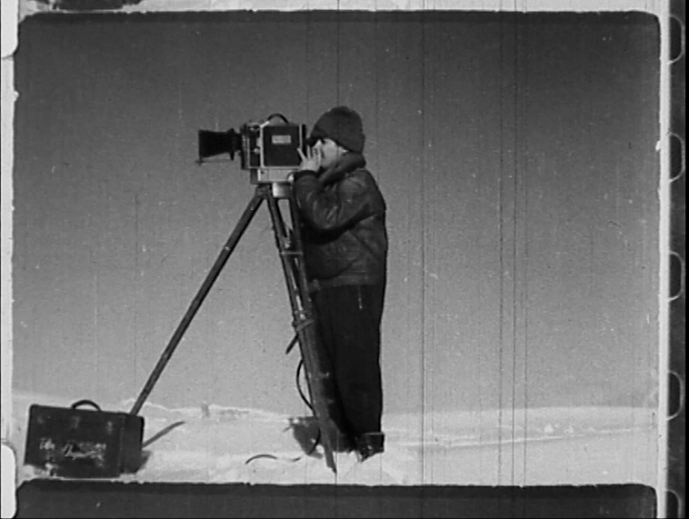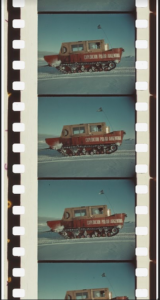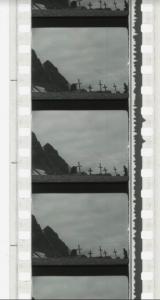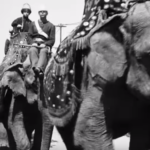Framing Antarctica: Argentina’s Icy Film Legacy

A cameraman for “Sucesos Argentinos” (Argentinian Events newsreel company) on location in 1947. All images courtesy of Museo del Cine Palbo C. Ducrós Hicken, Buenos Aires
By Peter Monaghan
Argentinians have been making films about Antarctica for 120 years, but they’ve been collecting and preserving them for far fewer.
Now, at the Museo del Cine Palbo C. Ducrós Hicken, in Buenos Aires, Andrés Levinson and his colleagues are running a major project to preserve that distinctive film legacy.

The distinctive Perro Polar Argentino (Argentinian Polar Dog), now extinct. From “Introducido en las bases argentinas en los años cincuenta” of 1957.
To date they have identified some 100 Antarctic films in various archives or in the hands of private collectors, and they have begun preserving and digitizing as many as they can while also screenings some of them for the public.
The films bear witness, says Levinson, the Chief Film Curator at the museum, to “how people survived in Antarctica with almost no communication with the world, in very difficult conditions, with very simple technology.”
Argentinian film relating to Antarctica began in 1902 with Eugenio Py, who was French born but resided in Argentina from around 30 years of age until his death in 1924 at 65. Most significant among early films was Among the Ice of the Orkney Islands (Entre los hielos de las islas Orcadas), a 1927 documentary film about Argentinian scientific activities made by meteorologist, explorer, and diplomat José Manuel Moneta. He took part in four campaigns to “the White Continent.”
In the course of his academic research, Levinson became aware of Argentina’s legacy of Antarctica-related film and of how extensive it was as a result of interest from many fields, academic, governmental, and exploratory.
In one sense, the scope of film records should surprise no one because historically Argentina has had a geopolitical interest in the continent since the mid-19th century, and it is not far distant from it. Still, says Levinson, he was at first surprised, then delighted, to discover how extensive the film record is. What the films reveal has been astonishing, he says; even the early films, despite the limits of film technology of the time, are visually “really incredible, really beautiful.”
He at first knew of only a few films, but when he and colleagues formed a research team, and additional colleagues began to join in, many more quickly surfaced. It helped, he says, that as soon as the archivists began to investigate the film record, “immediately some people from the national Antarctic Institute and other areas of government who have an interest in Antarctica got in touch with us.” They were curious about what Levinson and his team were finding.
It became apparent that fascination with the Antarctica film legacy was in part political — like many other countries, Argentina has long asserted sovereignty over part of the continent — but more compelling to him and his team, Levinson says, was the range of other connections to the film history, particularly relating to exploration and scientific investigation.
Now, over the course of 10 years, the researchers have located some 100 films — “a lot more than we expected,” he says. They date from 1927 to the late 1980s, with the end of that range determined largely by the researchers’ decision to limit their collection to footage shot on film stock and not on video. He says of the black-and-white and color films: “Those are amazing; they provide many different points of view.”
As he wrote in an essay in Journal of Film Preservation in April 2021, “these films are beautiful representatives of a very special way of capturing reality, made with analogue technology, their segments of reality inscribed in silver halide on celluloid film stock. They show a unique kind of aesthetic, a unique kind of light, one that belongs exclusively to Antarctica and the past.”
Harsh conditions for humans, and films
The project launched officially in 2018 as the Project for the Preservation of Argentina Antarctic Cinema, with the Museo del Cine partnering with the Argentina Antarctic Institute.
Many of the films located or collected display physical deterioration. Parts of many are missing; many are scratched, or stricken by vinegar syndrome, or have lost emulsion (the thin layer of silver where the film image forms upon exposure to light).
After cataloging and inspection, project participants began work of photochemical preservation and digitization. Digitized films are combined with information and other metadata, and are being loaded onto the website of the Association of Friends of the Film Museum (Asociación de Amigos del Museo del Cine) and the YouTube channel of the Argentine Antarctic Institute (Instituto Antártico Argentino). The project also offers public screening of the films at festivals and symposiums as well as international retrospectives of Antarctic film.
Conceptions of the White Continent
Robert Flaherty’s 1922 film Nanook of the North, first shown in Argentina in 1924, drew enormous attention there. Interest in southern exploration remained high after Roald Amundsen’s expedition to the South Pole in 1911, which an Argentinian businessman, Pedro Christophersen, largely underwrote.
Encouraged by the popularity of Nanook, Federico Valle, a major Argentine film producer, re-released a 10-minute, currently lost film that his cameraman Alberto Sorianello had shot in Antarctica in 1921, Viaje al fin del mundo (Journey to the End of the World).
The scene was set for Argentine cinematographers’ draw to the continent. Between 1925 and 1927, as mentioned, José Manual Moneta, while heading the Meteorological Station at Laurie Island, filmed his documentary Among the Ice of the Orkney Islands (Entre los hielos de las islas Orcadas). In fact, he shot it twice. After his first shoot, his film elements and those of many other film projects perished in a fire at the Valle film facility. So Moneta returned to South Orkney in the 1926-27 expedition season and shot more film, aided by improved equipment.
He returned to Buenos Aires in 1928 and produced and presented his film. Press reports of the day praise its depictions of “landscapes of a beauty unknown until now. The Antarctic fauna offer plenty of images of interest.”
The press was particularly taken by “the picturesque life” of penguins.
To the great benefit of filmmaking on the continent, once filmmakers stepped foot on the icy shores, they were there for the season – a year, generally. That, as the Argentine Antarctic Institute’s Pablo Gabriel Fontana has noted, increased the likelihood of capturing “practices internalized by scientists overwintering on permanent stations.” Films show, he suggests, “a new form of human activity in Antarctica in a way that differentiates it from the most characteristic elements of the Heroic Age.”
 That was true even of the earliest films, such as Moneta’s, Levinson has written. Moneta and his colleagues, although they often imitate Flaherty’s Nanook in showing, for example, a seal hunt, also record “the scientific work, the expeditions’ members daily activities, and their coexistence within their small building. The power of these images, together with a precise and, at time, very dynamic montage, make the film a quite remarkable cinematographic composition.”
That was true even of the earliest films, such as Moneta’s, Levinson has written. Moneta and his colleagues, although they often imitate Flaherty’s Nanook in showing, for example, a seal hunt, also record “the scientific work, the expeditions’ members daily activities, and their coexistence within their small building. The power of these images, together with a precise and, at time, very dynamic montage, make the film a quite remarkable cinematographic composition.”
That style was taken up again in the late 1930s when the newsreel company Sucesos Argentinos (Argentinian Events), sent a cameraman south to bring back images. (The Project for the Preservation of Argentina Antarctic Cinema has restored that film.)
Taken together, says Levinson, the Argentine Antarctica films provide a sense of what the White Continent has meant to Argentina across a range of endeavors. He says they shed light on relatively little known aspects of the history of a country that has been sending expeditions to the continent since 1904, and films from over the decades are “valuable contributions to telling this story.”
 The films also demonstrate that while Antarctica has long been a terrain of international political contention, the countries involved in such disputes have long collaborated in many ways.
The films also demonstrate that while Antarctica has long been a terrain of international political contention, the countries involved in such disputes have long collaborated in many ways.
Says Levinson: “Through the project we get to know Antarctic people — that’s what we call people who have been there — and their connection with the place. So, now we feel it much close, in some ways it becomes a familiar place.
“It’s amazing how things really change after spending some time in Antarctica. We spent two months during last summer as part of our project. We traveled with our 16mm projector and with original 16mm prints, so we were able to screen some of our Antarctic films to the people who are living in the military bases. And this was a very special experience.”
His team extensively filmed the events of its visit, “and right now we are working on a documentary film about the history of the project, from the discovery of the first Antarctic film in 2010, Moneta’s Among the Ice of the South Orkney Islands, from 1927, to the screening of the Antarctic films in South Orkney Base and Marambio Base in 2022.” Those could be moving events, he says:
“During the screenings we had an incredible audience, they were fascinated with what the films were showing: people like them, in the same places by 60 or 70 years ago. It was very emotional for some of them. They could feel the connection with those who came before.”
Previous Post: Data from thousands of surveillance cameras confirms that protected areas safeguard species diversity
Next Post: An Archive That Keeps the Waves Rolling







